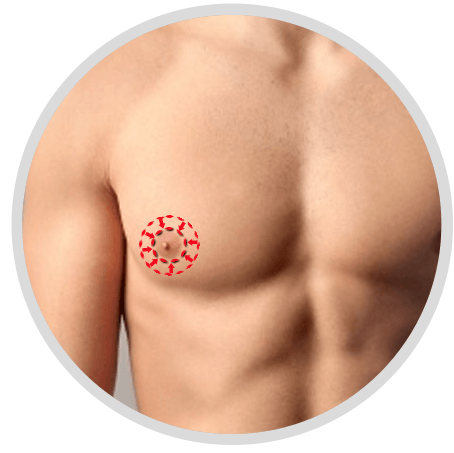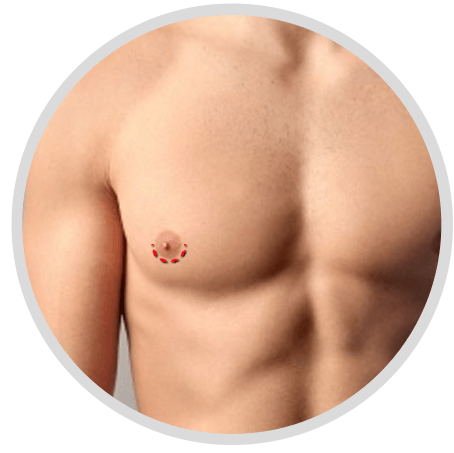Gender Fluid and Cis TOP Surgery
This Is Not a Breast Reduction, This Is Chest Masculinization
You do not need to be transitioning to have TOP surgery. Just as gender identification is a spectrum, TOP surgery also applies to a spectrum of diverse patient populations. Whether you are non-binary, gender fluid, or cis, if you identify with having a more masculine chest, then chest masculinization surgery may be right for you. This is not a breast reduction. This is chest masculinization and there are a variety of people who desire a more masculine chest.
Several anatomic features differentiate a masculine from a feminine chest. For instance, a male nipple and areola are smaller and located in a higher and more lateral position than a female areola that is typically centered on the breast mound.
Top Surgery Procedures

Double Incision Top Surgery
Patients who have medium to large chests benefit most from the double-incision top surgery technique. In this procedure, an incision is made along the lower breast fold and the breast tissue is meticulously reduced. The excess skin is then reduced to create a pleasing, more masculine contour. The nipple and areola, which are removed at the beginning of the procedure are then re-sized and sutured to the appropriate position to give a more masculine appearance. Liposuction of the axilla and lateral breast and chest are also performed as necessary. The advantage of this procedure is that it offers the best contour for the chest. The main disadvantage is that nipple sensation is typically lost. The final incisions, which are along the lower border of the chest and around the areola fade over time.
The double incision technique is an outpatient procedure performed under general anesthesia. The surgery generally takes between 2.5 – 3.5 hours.
Double Incision Top Surgery Post-Op Care
After surgery, you will have a drainage tube in place on each side. Dr. Dadvand contacts all of his patients the next day to go over instructions and drain management. The drains stay in place until they each put out less than 25ml/24 hours. This usually occurs between 4 – 7 days. You will also have compression dressings and a compression garment.
Dr. Dadvand will then see you one week after surgery to remove the drains, any sutures, and the compression dressings. This is the Grand Reveal, a very emotional day for everyone involved!
You will continue to wear the compression garment for six weeks on average. Dr. Dadvand will see you at this time to determine when you may resume exercise. Walking is permitted after surgery, but strenuous activity, exercise, and regular lifting of your arms over your head are to be avoided. This is to ensure that the swelling is controlled as well as to decrease the stress on the incisions.
Periareolar Top Surgery
Patients who have small to medium breasts (A to B cup) and large areola with minimal to no excess skin benefit most from the periareolar surgery technique. An incision is made around the entire areola and breast and excess fatty tissue is taken out. A concentric incision is then made and the intervening skin is removed. A purse-string suture is then used to tighten the skin around the new areola. The final incision is limited to the areola. In certain cases, this may need to be performed in two stages to ensure adequate blood supply to the nipple and areola.
The periareolar technique is an outpatient procedure performed under general anesthesia. The surgery generally takes between 3 – 4 hours.

Periareolar Surgery Post-Op Care
After your periareolar top surgery, you will have a drainage tube in place on each side. Dr. Dadvand contacts all of his patients the next day to go over instructions and drain management. The drains stay in place until they each put out less than 25ml/24 hours. This usually occurs between 3 – 5 days. You will also have compression dressings and a compression garment.
Dr. Dadvand will then see you one week after surgery to remove the drains, any sutures, and the compression dressings. This is the Grand Reveal, a very emotional day for everyone involved!
You will continue to wear the compression garment for six weeks on average. Dr. Dadvand will see you at this time to determine when you may resume exercise. Walking is permitted after surgery, but strenuous activity, exercise, and regular lifting of your arms over your head are to be avoided. This is to ensure that the swelling is controlled as well as to decrease the stress on the incisions.
Keyhole Top Surgery
Patients who have small chests benefit most from the keyhole top surgery technique. In this procedure, an incision is made along the lower border of the areola and breast tissue is taken out. This is accompanied by liposuction as necessary. The areola is not reduced in size but the nipple can be reduced in size. The sensation is typically left intact.
The keyhole technique is an outpatient procedure performed under general anesthesia. The surgery generally takes between 2 – 3 hours.

Keyhole Top Surgery Post-Op Care
After surgery, you will have a drainage tube in place on each side. Dr. Dadvand contacts all of his patients the next day to go over instructions and drain management. The drains stay in place until they are each putting out less than 25ml/24 hours. This usually occurs between 3 – 4 days. You will also have compression dressings and a compression garment.
Dr. Dadvand will then see you when you are one week out from surgery to remove the drains, any sutures, and the compression dressings. This is the Grand Reveal, a very emotional day for everyone involved!
You will continue to wear the compression garment for 4-6 weeks on average. Dr. Dadvand will see you at this time to determine when you may resume exercise. Walking is permitted after surgery, but strenuous activity, and exercise are to be avoided. This is to ensure that the swelling is controlled and allow the skin to re-drape.
Ideal Candidates for Chest Masculinization | Top Surgery Beverly Hills
Non-binary, Gender Fluid, and Cis people who identify with having a masculine chest are suitable candidates for top surgery. These patients do not have gender dysphoria or are ever planning on transitioning but do not feel comfortable with their breasts and prefer a masculine-shaped chest.
Consult Dr. Dadvand to learn more about his Top Surgery Beverly Hills candidate criteria, treatment guidelines, recovery expectations and results.

By Dr. Babak Dadvand
Dr. Babak Dadvand is a board-certified plastic surgeon and portrait painter, providing a distinctive fusion of artistic and surgical skills to achieve exceptional outcomes, all while maintaining a robust ethical framework that prioritizes patient trust and satisfaction.







 4.9 stars - based on 106 reviews
4.9 stars - based on 106 reviews
 4.9 stars - based on 73 reviews
4.9 stars - based on 73 reviews
